A Mid-Week Meteor Shower from Orion, and an Evening Moon Jumps under Giant Planets and then Exhibits an X and L-O-V-E on Friday!
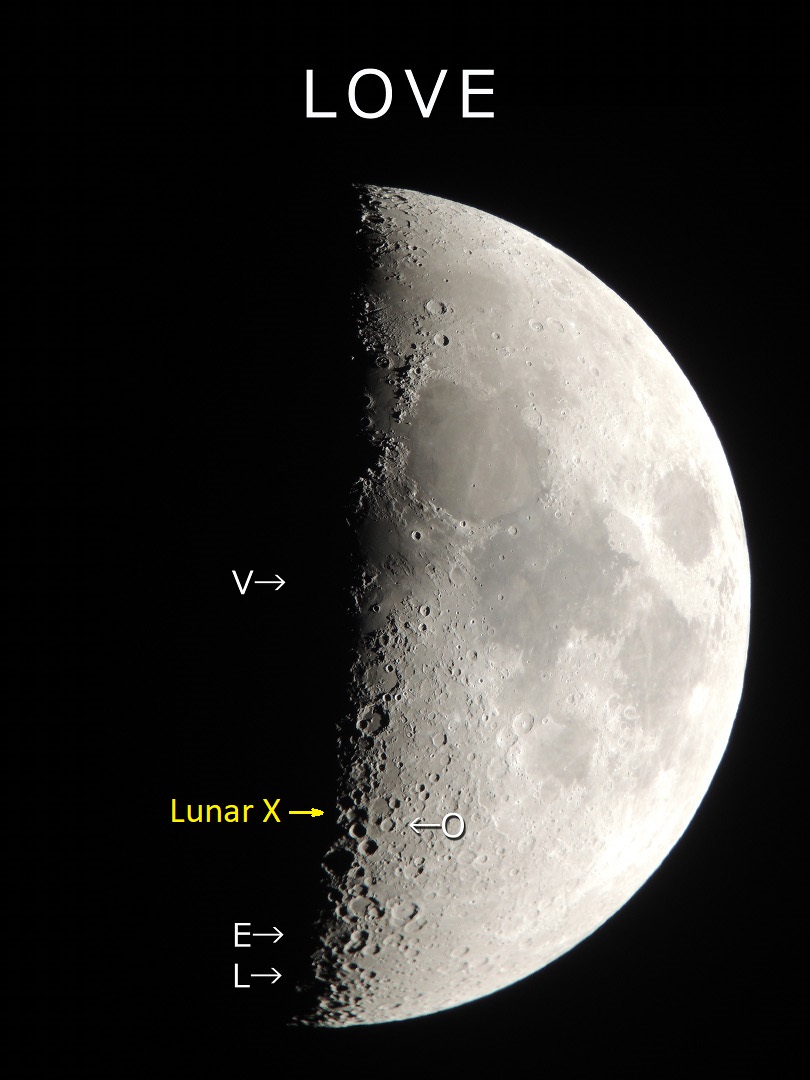
Hello, mid-October Stargazers!
Here are your Astronomy Skylights for the week of October 18th, 2020 by Chris Vaughan. Feel free to pass this along to your friends and send me your comments, questions, and suggested topics. You can also follow me on Twitter as @astrogeoguy! Unless otherwise noted, all times are expressed in Eastern Time. To see the pictures more clearly, right-click and save them to your computer, and to subscribe to these emails please click this MailChimp link.
I can bring my Digital Starlab portable inflatable planetarium to your school or other daytime or evening event, or teach a session online. Contact me through AstroGeo.ca, and we’ll tour the Universe, or the Earth’s interior, together!
Mars will still be a sight to behold this week – and don’t forget to enjoy the duo of bright Jupiter and dimmer Saturn over in the west before late evening – and Venus gleaming in the eastern sky before dawn! The moon will be waxing prettily in the evening sky – visiting Jupiter and Saturn on Thursday, and then sporting a lunar X and the letters L-O-V-E on Friday. Read on for your Skylights!
Orionids Meteor Shower
We’ve finally entered meteor shower season! Over the next few months, we’ll experience a wave of several showers. The excellent Orionids Meteor Shower, which is observable world-wide, happens every year between September 23 and November 27 when the Earth plows through a cloud of fine particles dropped by repeated past passages of Comet Halley. The Orionids (for short) will peak in the hours between midnight and dawn (in your local time zone) on Wednesday, October 21. At that time, the sky overhead will be pointing toward the densest region of the particle field, generating as many as 10-20 meteors per hour.
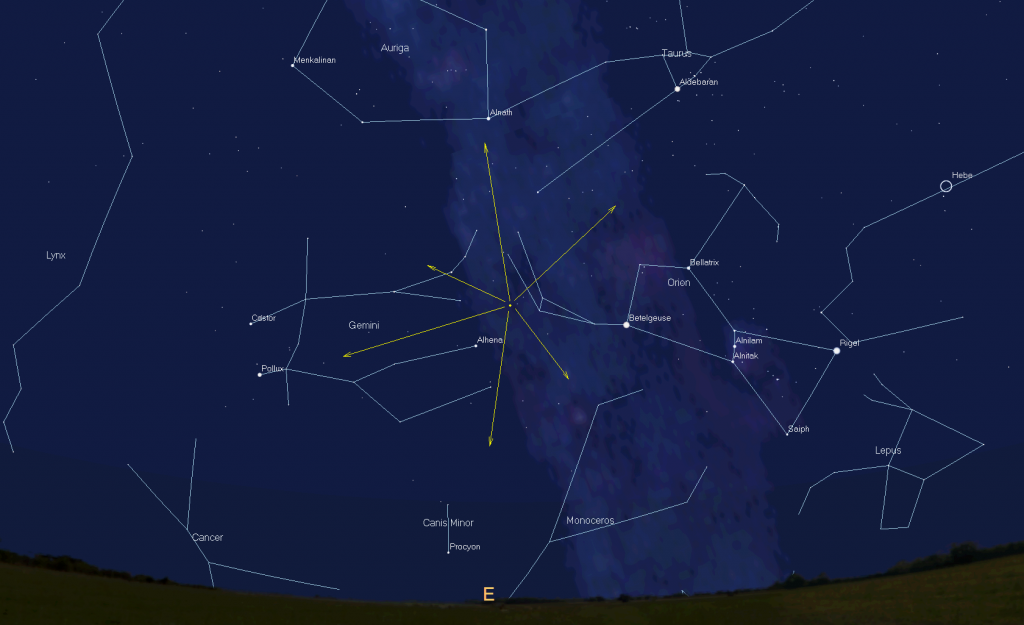
This shower has a broad period of activity because the Earth is crossing the comet’s orbit at a shallow angle. While the Orionids will linger until late November, they will decrease in quantity every night after Wednesday’s peak.
The meteors can appear anywhere in the sky, but true Orionids will be travelling in a direction away from a location in the sky (called the radiant) that is positioned near the bright red star Betelgeuse in the constellation of Orion – giving this shower its name.
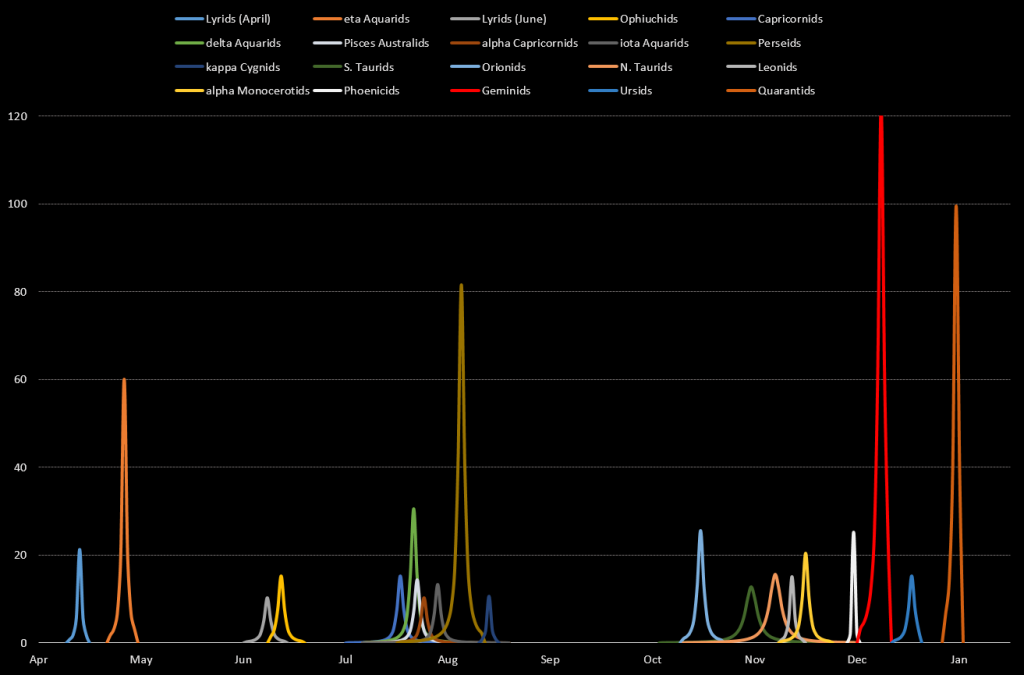
Although not too numerous, Orionids are known for being bright and fast-moving. On the peak night, the young, crescent moon will set during evening – leaving the overnight sky dark for meteor-watching. You can watch for meteors on Tuesday before midnight, too – but many of them will be obscured below the Earth’s horizon.
To see the most meteors, get away from light-polluted urban skies and find a dark site with plenty of open sky. Don’t bother with binoculars or a telescope – their fields of view are too narrow for meteors. And don’t watch the sky near the radiant – those meteors will be travelling towards you and will produce very short streaks. Just keep your eyes on the sky overhead.
Avoid bright white light from phones or tablets – it will spoil your eyes’ dark adaptation (red light is fine). If the peak night forecast calls for clouds, try the nights before or the nights after. Happy hunting!
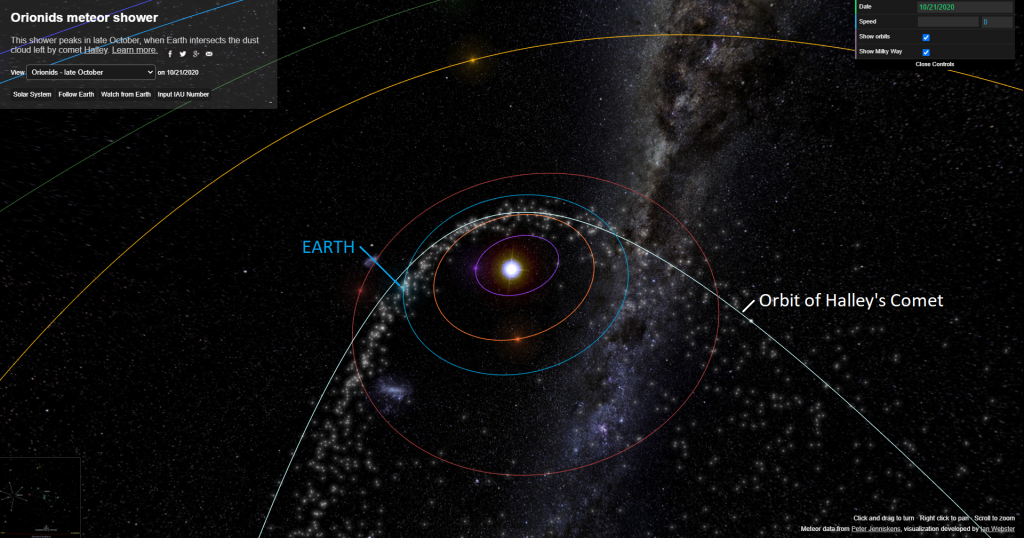
My friend Blake Nancarrow created a very informative graph of meteor shower intensity through the year. His interesting personal blog is at http://blog.lumpydarkness.com/. You can play with a very cool, interactive 3D meteor shower visualizing tool at https://www.meteorshowers.org/. Using that tool, I made a view of the solar system geometry on the peak night.
Zodiacal Light
For about half an hour before dawn during the moonless periods in September and October every year, the near-vertical position of the morning ecliptic favors the appearance of the zodiacal light in the eastern sky – for observers at mid-northern latitudes. Zodiacal light is sunlight scattered by interplanetary particles concentrated within the plane of the solar system. It is best seen in areas free of urban light pollution.
From now until the next full moon (on October 31), look just above the eastern horizon for a broad wedge of faint light centred on the ecliptic, which extends downward from Venus and the stars of southern Virgo (the Maiden). Don’t confuse the zodiacal light with the Milky Way, which is positioned further to the southeast. I posted a nice picture of it here.
The Moon Shows an X and some L-O-V-E!
Tonight (Sunday) after sunset, look low in the southwestern sky for the delicate sliver of the young crescent moon. For the rest of this week, the moon will wax fuller and linger longer in the darkening sky – giving everyone around the world a perfect opportunity to appreciate our nearest celestial neighbour. While the moon’s Earth-facing hemisphere is filling up with light each night, the sun is rising slowly over the lunar surface. The curved, pole-to-pole boundary that divides the lit and dark hemispheres is called the terminator. It marks the line of sunrise (or sunset, when the moon is waning).
The areas on the moon near the terminator are being lit by nearly-horizontal rays of sunlight – casting long shadows to the west of every crater rim, mountain peak, hill, and ridge. With no atmosphere to scatter light, those shadows are deep black – creating spectacular vistas in binoculars and any sized telescope. The view changes every night. And, with sunset arriving so early nowadays, even the younger children can stay up late enough to enjoy a look!
On Wednesday and Thursday, the waxing crescent moon will cross through the stars of Sagittarius (the Archer). The moon’s monthly visit with the gas giant planets Jupiter and Saturn will occur in the southwestern sky after dusk on Thursday. The moon will form a neat triangle below and between the two planets – with bright Jupiter to the moon’s upper right, and somewhat dimmer Saturn positioned to the moon’s upper left. The trio, which will set in mid-evening, will offer a lovely wide field photo opportunity when composed with some interesting foreground scenery. The moon will spend the rest of this week journeying through Capricornus (the Sea-Goat) and Aquarius (the Water-Bearer).
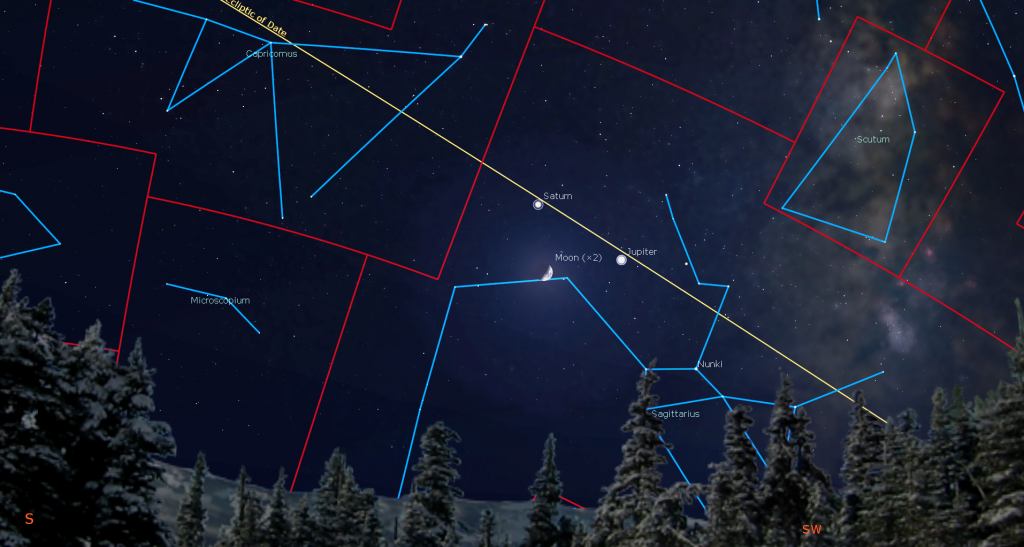
The moon will complete the first quarter of its orbit around Earth at 9:23 am EDT (or 13:23 Greenwich Mean Time) on Friday. At that time, the relative positions of the Earth, sun, and moon will cause us to see it half-illuminated – on its eastern side. At first quarter, the moon always rises around noon and sets around midnight, so it is also visible in the afternoon daytime sky.
Several times a year, for a few hours near its first quarter phase, a feature on the moon called the Lunar X becomes visible in strong binoculars and backyard telescopes – and this month it will occur on Tuesday night! When the rims of the craters Purbach, la Caille, and Blanchinus are illuminated from a particular angle of sunlight, they form a small, but very obvious X-shape. The phenomenon called is pareidolia – the tendency of the human mind to see familiar objects when looking at random patterns. The Lunar X is located near the terminator, about one third of the way up from the southern pole of the Moon (at lunar coordinates 2° East, 24° South). The prominent round crater Werner sits to its lower right.
Between 10 pm and 11 pm EDT on Friday night, the Lunar X is predicted to peak in intensity – but the phenomenon will be visible for an hour more on either side of that window. Simply adjust for your difference from the Eastern Time zone. This event should be visible anywhere on Earth where the moon is shining in a dark sky during that time window. For the Great Lakes Region, the moon will be positioned low in the southwestern sky – but for observers farther west the moon will sit higher.
At the same time, you can look for the Lunar V and the Lunar L. The “V” is produced by the small crater Ukert when combined with some ridges to the east and west of it. It is located a short distance above the moon’s equator at lunar coordinates 1.5° East, 8° North. For a further challenge, see if you can see the letter “L” down near the moon’s southern pole. Its position is to the southwest of three prominent and adjoining craters named Licetus, Cuvier, and Heraclitus, which combine to form a Mickey Mouse’s head shape. Some people claim they can see a letter-E on the moon during the Lunar X period, too. Then, by picking a round crater along the terminator to serve as the “O”, you can spell L-O-V-E! Let me know if you see them.

On Saturday evening, the terminator will fall just to the left (or lunar west) of Rupes Recta, also known as the Straight Wall. This feature is very obvious in good binoculars and backyard telescopes. The rupes, Latin for “cliff”, is a north-south aligned fault scarp that extends for (110 km across the southeastern part of Mare Nubium, which sits in the lower third of the moon’s Earth-facing hemisphere. The Straight Wall is always prominent a day after first quarter, and again one day before last quarter. For reference, the very bright crater Tycho is located due south of the Straight Wall.
The Planets
At around 7 pm local time, very bright, white Jupiter will pop into view in the lower part of the southern sky. A short time after that, dimmer, yellowish Saturn will appear a palm’s width to Jupiter’s left (or 6 degrees to the celestial east). Our window of opportunity for clear views of those two planets is starting to close. After 9:30 pm local time, they will be getting low in the southwestern sky, and shining through a much thicker blanket of Earth’s atmosphere – you might even see them twinkle! Thankfully, the earlier sunsets are providing us more viewing time.
Good binoculars will reveal Jupiter’s four large Galilean moons named Io, Europa, Ganymede, and Callisto as they dance around the planet from night to night. Even a modest-sized telescope will show Jupiter’s brown equatorial belts and the famous Great Red Spot (or GRS, for short) – if the air is steady. Due to Jupiter’s 10-hour period of rotation, the GRS will appear every second or third night at your location on Earth. In the Eastern Time zone, the Great Red Spot will be crossing the planet’s disk after dusk on Monday and Wednesday. It will also be visible during late evening tonight (Sunday) and Friday.
From time to time, the round, black shadows cast onto Jupiter by its Galilean moons are visible in amateur telescopes as they cross (or transit) the planet’s disk for a few hours. On Saturday, October 24 from 7:22 to 9:35 pm EDT, Io’s shadow will be traveling across Jupiter. The event will be visible anywhere on Earth where Jupiter is above the horizon during the time windows (adjusted to your local time zone). Other places will see different transits.
Saturn is a spectacular sight in any backyard telescope. Even a small one will show you Saturn’s rings. In a telescope, the rings are almost as almost as wide as Jupiter’s disk. See if you can see the Cassini Division. It’s the narrow, dark gap that separates Saturn’s main inner ring from its outer one. From now until December 21, Jupiter will decrease its distance from slower-moving Saturn!
Your telescope should also reveal several of Saturn’s moons – especially its largest, brightest moon, Titan! Because Saturn’s axis of rotation is tipped about 27° from vertical (a bit more than Earth’s axis), we are seeing the top surface of its rings – and its moons can arrange themselves above, below, or to either side of the planet. The trick for seeing more moons is to watch continuously for a minute or two, and let the dimmer, closer-in moons appear whenever the air stabilizes. During evening this week, Titan will migrate counter-clockwise around Saturn, moving from upper right of Saturn tonight (Sunday) to the lower left of the planet next Sunday. (Remember that your telescope might flip the view around.) Fun fact: There’s a Lake Ontario on Titan!
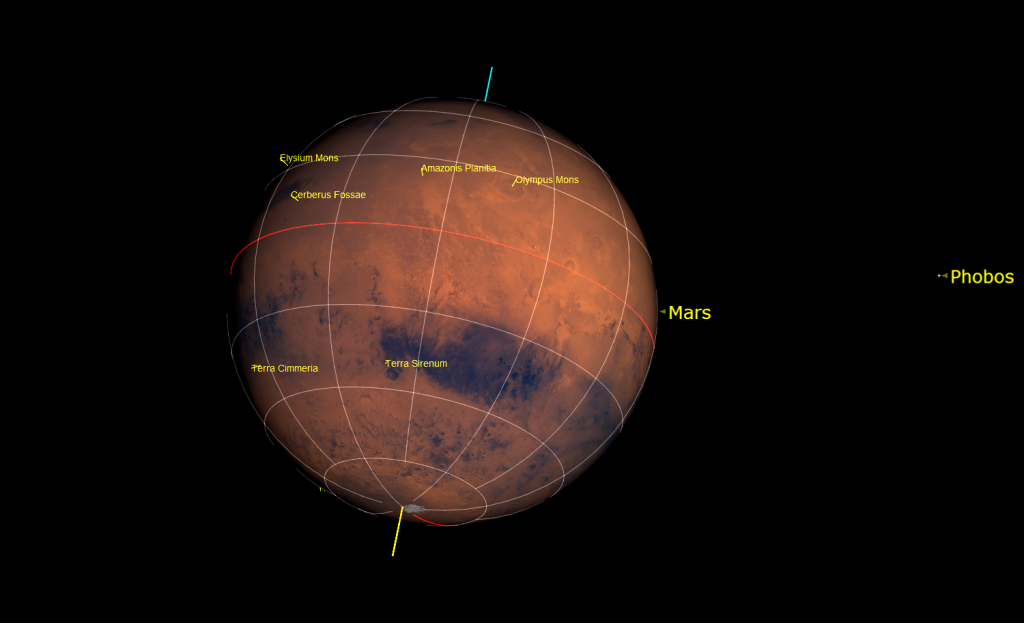
Mars is still very bright! This week, very bright, reddish-tinted Mars will be rising in the east shortly at about 6 pm in your local time zone. It will climb to its highest point – slightly more than half-way up the southern sky at about midnight local time (earlier than last week!), and then set in the west before sunrise. Because Earth is passing Mars on the “inside track” of the solar system, Mars is moving retrograde, causing the planet to appear to travel westward compared to the narrow “V” of modest stars at the bottom of the constellation of Pisces (the Fishes). You won’t see that motion unless you carefully note the positions of Mars and the surrounding stars changing over several nights.
Viewed in a telescope this week, Mars will display the dark Terra Sirenum and the bright Amazonis Planitia regions. The latter hosts the giant volcano Olympus Mons.
After 8 pm local time worldwide, the ice giant planets Uranus and Neptune will be above the horizon, too – with Mars between them. Blue-green Uranus will cross the sky among the stars of southern Aries (the Ram). It is located a fist’s diameter below and between Aries’ two brightest stars Hamal and Sheratan, and two fist diameters to the lower left (or 20° to the celestial east) of much brighter Mars. Try for Uranus after 9:30 pm, when it will be higher in the sky. I posted a detailed sky chart for Uranus here.
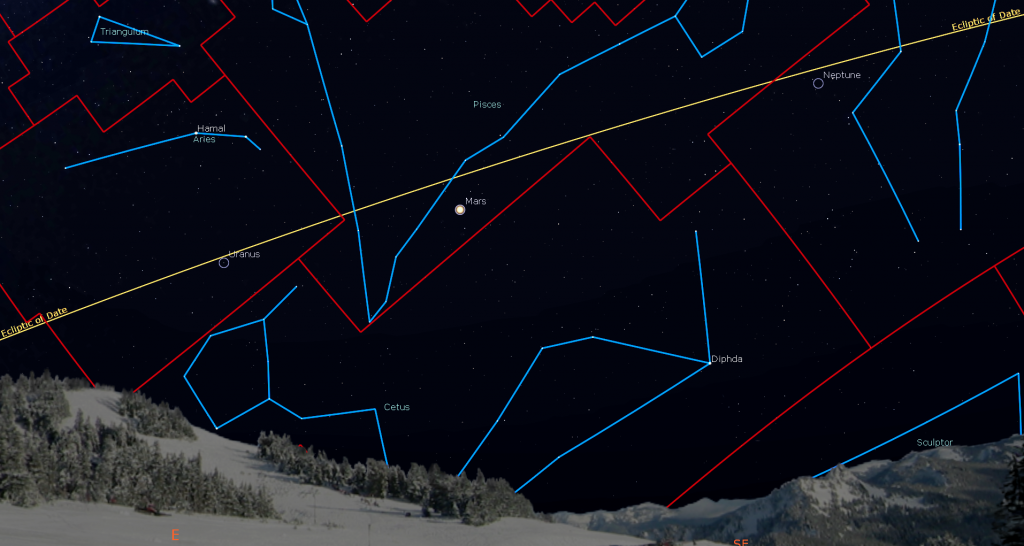
Neptune, which rises in late afternoon, is located among the stars of northeastern Aquarius (the Water-Bearer), about two finger widths to the left (or 2 degrees to the celestial east) of the medium-bright star Phi Aquarii or φ Aqr. This week, Neptune will already be in the lower southeastern sky after dusk. Then it will climb higher until 10:45 pm local time, when you’ll get your clearest view of it while it’s halfway up the southern sky. I posted a detailed sky chart for Neptune here.
Venus has been gleaming in the eastern pre-dawn sky for some time now. It will rise at about 4:30 am local time this week, and then remain visible in the eastern sky until sunrise while it is carried higher by the rotation of the Earth. Viewed in a backyard telescope, Venus will show a gibbous, 80%-illuminated shape. This week, the planet will be depart Leo (the Lion) for Virgo (the Maiden). Venus is shifting towards the sun – but the later sunrises at this time of year will allow it to shine in a dark, pre-dawn sky until early December! And while you’re taking in the show, enjoy a view of the extremely bright star Sirius, and the winter constellation of Orion (the Hunter) sitting well off to Venus’ upper right.
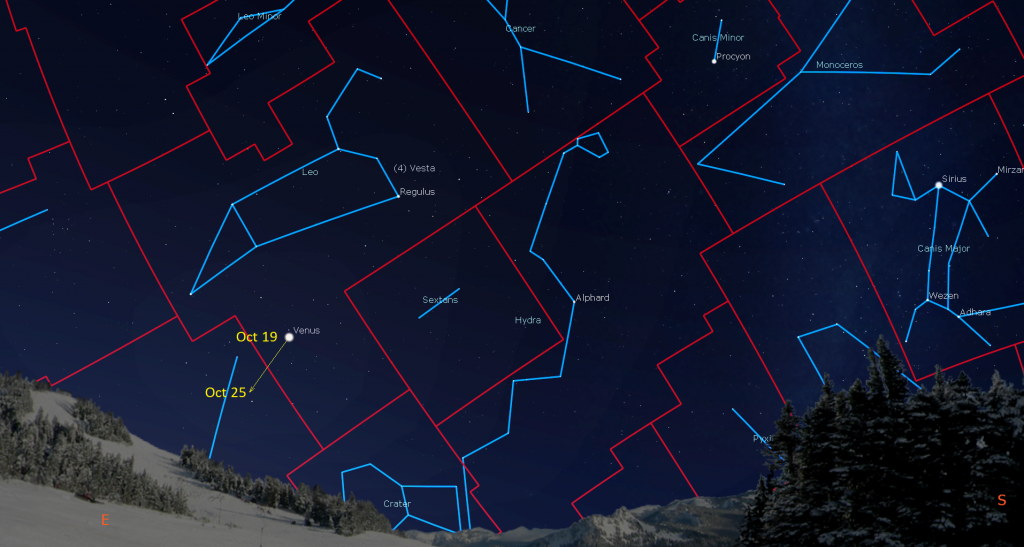
On Friday, October 23, the dwarf planet Ceres will complete a retrograde loop that began in July – causing it to temporarily cease its motion through the background stars. On this night, the magnitude 8.6 object will be located in the lower part of the southern evening sky – about a fist’s diameter to the upper right (or 9.5 degrees to the celestial northwest) of the very bright star Fomalhaut. After tonight, Ceres will resume its regular eastward motion through the stars.
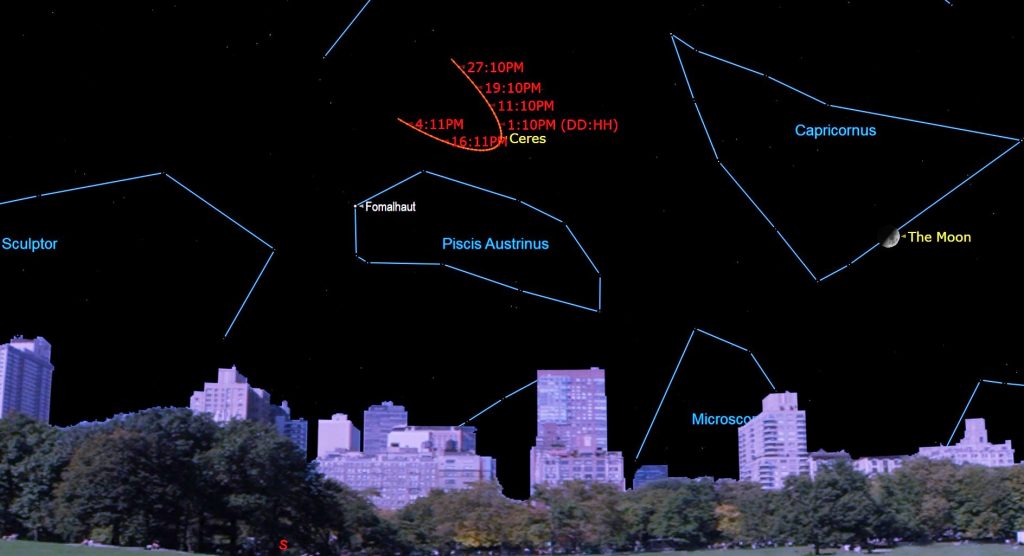
Pegasus Flies across the Sky
If you missed last week’s tour of the constellation Pegasus (the Winged Horse) I posted it, along with sky charts and pictures of the best objects, here.
Public Astro-Themed Events
Every Monday evening, York University’s Allan I. Carswell Observatory runs an online star party – broadcasting views from four telescopes/cameras, answering viewer questions, and taking requests! Details are here. Their in-person Wednesday night viewing has been converted to online via the observatory Youtube channel, where they offer free online viewing through their rooftop telescopes, including their new 1-metre telescope! Details are here.
My free, family-friendly Insider’s Guide to the Galaxy webcasts with Jenna Hinds of RASC National will return on Tuesday, October 20, when we’ll look at Out of this World Records – the biggest, smallest, brightest, and farthest constellations, stars, and planets – and more! You can find more details, and the schedule of future sessions, here and here. Don’t forget that Jenna and John Reid also stream on alternate Thursdays at 3:30 pm EDT as they progress through the RASC’s Explore the Universe certificate program.
The Canadian organization Discover the Universe is offering astronomy broadcasts via their website here, and their YouTube channel here.
On many evenings, the University of Toronto’s Dunlap Institute is delivering live broadcasts. The streams can be watched live, or later on their YouTube channel here.
The Perimeter Institute in Waterloo, Ontario has a library of videos from their past public lectures. Their Lectures on Demand page is here.
Keep looking up, and enjoy the sky when you do. I love questions and requests. Send me some!